Honey is a mixture of sugars and other compounds. With respect to carbohydrates, honey is mainly fructose (about 38.5%) and glucose (about 31.0%), making it similar to the synthetically produced inverted sugar syrup which is approximately 48% fructose, 47% glucose, and 5% sucrose.Honey's remaining carbohydrates include maltose, sucrose, and other complex carbohydrates.As with all nutritive sweeteners, honey is mostly sugars and contains only trace amounts of vitamins or minerals.
Honey also contains tiny amounts of several compounds thought to function as antioxidants, including chrysin, pinobanksin, vitamin C, catalase, and pinocembrin.The specific composition of any batch of honey depends on the flowers available to the bees that produced the honey.
Typical honey analysis.
- Fructose: 38.2%
- Glucose: 31.3%
- Sucrose: 1.3%
- Maltose: 7.1%
- Water: 17.2%
- Higher sugars: 1.5%
- Ash: 0.2%
- Other/undetermined: 3.2%
Honey has a density of about 1.36 kilograms per liter (36% denser than water).
Preservation
Because of its unique composition and chemical properties, honey is suitable for long term storage and is easily assimilated even after long preservation. Honey has been preserved for decades and even centuries. The key to preservation is limiting access to humidity. In its cured state, honey has a sufficiently high sugar content to inhibit fermentation. If, however, the honey is exposed to moist air, its hydrophilic properties will pull moisture into the honey, eventually diluting it to the point that fermentation can begin. Honey sealed in honeycomb cells by the bees is considered by many to be the ideal form for preservation.

Regardless of preservation, honey may crystallize over time. Crystallization does not affect the flavor, quality or nutritional content of the honey though it does affect color and texture. The pace of crystallization is a function of storage temperature, availability of "seed" crystals and the specific mix of sugars and trace compounds in the honey. Tupelo and acacia honeys, for example, are exceptionally slow to crystallize while goldenrod will often crystallize still in the comb. Most honeys crystallize fastest between about 50 and 70 °F (10 and 21 °C).
In medicine
For at least 2700 years, honey has been used by humans to treat a variety of ailments through topical application, but only recently have the antiseptic and antibacterial properties of honey been chemically explained.Wound gels that contain antibacterial raw honey and have regulatory approval for wound care are now available to help conventional medicine in the battle against drug resistant strains of bacteria MRSA. As an antimicrobial agent honey may have the potential for treating a variety of ailments. One New Zealand researcher says a particular type of honey (Manuka honey) may be useful in treating MRSA infections. Antibacterial properties of honey are the result of the low water activity causing osmosis, hydrogen peroxide effect, high acidity, and the antibacterial activity of methylglyoxal.
Honey appears to be effective in killing drug-resistant biofilms which are implicated in chronic rhinosinusitis
Practical considerations for the clinical use of honey
- The amount of honey required on the wound relates to the amount of fluid exuding from the wound diluting it. The frequency of dressing changes required will depend on how rapidly the honey is being diluted by exudate. If there is no exudate, dressings need to be changed twice-weekly to maintain a 'reservoir' of antibacterial components as they diffuse into the wound tissues.
- To achieve best results the honey should be applied to an absorbent dressing prior to application. If applied directly to the wound, the honey tends to run off before a secondary dressing is applied to hold it in place.
- Honey will not soak readily into absorbent dressings. Soaking is facilitated by warming the honey to body temperature and/or adding 1 part water to 20 parts honey to make the honey more fluid.
- In some situations a 'blister' of honey can be held on a wound using an adhesive film dressing. Honey can be used to treat cavity wounds in this way, although this approach is not suitable for heavily exuding wounds.
- For moderately to heavily exuding wounds, a secondary dressing may be needed to contain seepage of diluted honey from the primary dressing. An occlusive dressing such as polyurethane film is best, as an absorbent secondary dressing tends to draw the honey away from the wound surface.
- A low-adherent dressing helps prevent the honey dressing sticking to the wound in cases where this is a problem. This dressing is placed between the wound and the honey dressing, but must be porous to allow the antibacterial components of the honey to diffuse freely into the wound bed.
- Alginate dressings impregnated with honey are a good alternative to cotton/cellulose dressings, as the alginate converts into a honey-containing soft gel.
- Any depressions or cavities in the wound bed need to be filled with honey in addition to using a honey-impregnated dressing. This is to ensure the antibacterial components of the honey diffuse into the wound tissues.
- Honey can safely be inserted into cavities and sinuses. It is water-soluble and easily rinsed out; any residues are bio-degradable (honey filtered in processing does not contain any foreign bodies). For sinuses with small openings a catheter on a syringe filled with honey is an effective way of applying honey.
- Since infection may lie in the tissues underlying the wound margins, honey dressings need to extend beyond the inflamed area surrounding a wound.
Wikipedia.com/honey
http://www.sciencedaily.com/releases/2008/10/081007192524.htm
http://www.honey2010.kk.usm.my/
Related articles by Zemanta


No comments:
Post a Comment